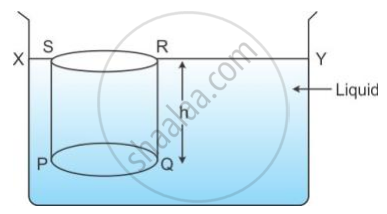Advertisements
Advertisements
प्रश्न
Deduce an expression for the pressure at depth inside a liquid.
उत्तर
Consider a vessel containing a liquid of density. Let the liquid be stationary. In order to calculate pressure at a depth, consider a horizontal circular surface PQ of area A at a depth h below the free surface XY of the liquid. The pressure on the surface PQ will be due to the thrust of the liquid contained in cylinder PQRS of height h with PQ as its base and top face RS lying on the frees surface XY of the liquid.

Total thrust exerted on the surface PQ
= Weight of the liquid column PQRS
= Volume of liquid column PQRS x density x g
= (Area of base PQ x height) x density x g
= (A x h) x ρ x g
This thrust is exerted on the surface PQ of area A. Therefore, pressure is given as shown below.
P = Thrust on surface / Area of surface
P = Ahρg / A = h ρ g
Thus, Pressure = depth x density of liquid x acceleration due to gravity
APPEARS IN
संबंधित प्रश्न
Why does a block of wood held under water rise to the surface when released ?
A body floats in a liquid when its weight becomes equal to the weight of the liquid displaced by its submerged part.
What is the unit of relative density?
Which of the following will sink or float on water? (Density of water = 1 g Cm-3) body B having density 2520 kg m-3
The diagram given below show a body floating in three different liquids. A, B and C at different levels.
(a) In which liquid does the body experience the greatest buoyant force?
(b) Which liquid has the least density?
(c) Which liquid has the highest density?

State whether pressure is a scalar or vector?
A simple U tube contains mercury to the same level in both of its arms. If water is poured to a height of 13.6 cm in one arm, how much will be the rise in mercury level in the other arm?
Given : density of mercury = 13.6 x 103 kg m-3 and density of water = 103 kg m-3.
Define upthrust and state its S.I. unit.
A body will experience minimum upthrust when it is completely immersed in :
